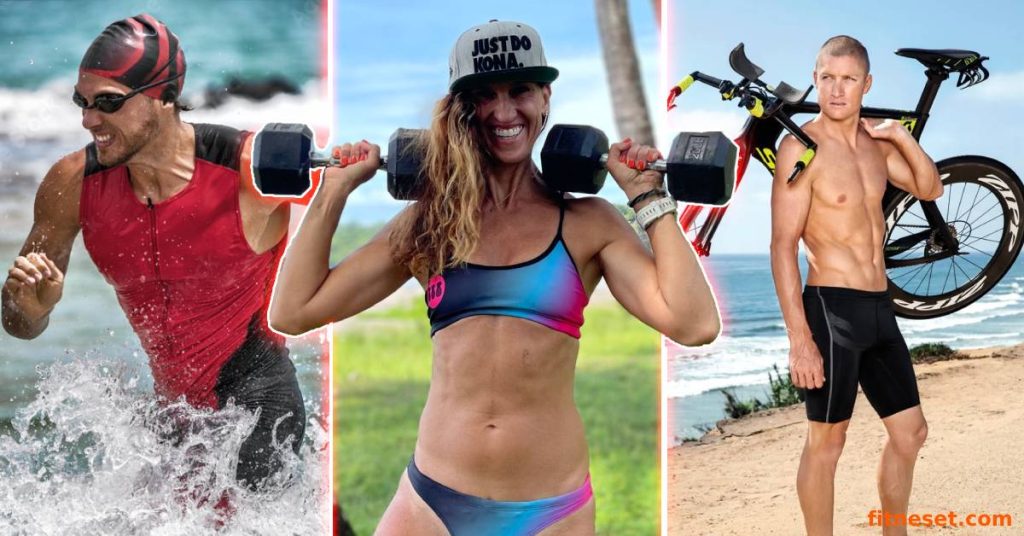If you are a Triathlete, a mere 30 minutes dedicated to strength training could be the key to unlocking your full potential. You may wonder why we said “Strength Training for Triathletes” so crucial and how it can revolutionize your swimming, biking, and running performance.
The answer lies in not only preventing injuries but also in significantly boosting your power and endurance.
Intrigued? Let’s dive into the details…
Table of contents
MORE keyboard_double_arrow_down LESS keyboard_double_arrow_up
Transforming Performance Through Strength Training in Just 2% of Your Day
Imagine a scenario where you just have to dedicate a mere 2% of your day to a practice that could significantly elevate your triathlon performance.
It should be a game changer right, if it is possible to do it in just 30 minutes? Don’t worry. Sometimes you may find it hard to do it within 30 minutes. But with time and enough practice, you will surely come to a stage where you can complete the training scedule just within 30 minutes.
For a fact, endurance athletes who neglect consistent strength training in their routines ultimately undermine their capacity to generate optimal muscular force. Through this approach, you will be able to go beyond merely building brute strength, as it enhances endurance and primes every muscle group for peak performance.
Let us walk you through how you, as triathletes, can improve your race times and endurance through strength training.
Why Is Strength Training for Triathletes Important?
We all know consistency is the key to getting better at any sport, especially for Triathlon. Plus, continuous training will make you disciplined and focused. This is a much needed factor to increase your chance of getting better every season.
With that objective in mind, you can now understand why famous triathletes include strength training as an essential component of their usual structured training.
Strength training is crucial for triathletes for several reasons:
1. Injury prevention:
Triathletes subject their bodies to significant repetitive stress through swimming, cycling, and running. Strength training helps to address muscle imbalances, strengthen stabilizing muscles through maintaining muscle mass, and improve overall structural integrity. Thus, it will reduce the risk of having injuries in vulnerable joints.
In summary:
- Stronger Foundations: Strength training strengthens muscles, tendons, and ligaments, creating a more resilient musculoskeletal system. This reduces your(as a triathlete) risk of overuse injuries caused by repetitive motions in swimming, biking, and running.
- Improved Balance and Stability: A strong core and other key muscle groups improve balance and stability, reducing your risk of falls and other accidents during training and racing.
2. Improved performance:
You can enhance power, speed, and endurance through Strength training, which is essential for all three triathlon disciplines. Stronger muscles can generate more force, leading to improved performance in swimming, cycling, and running. Surely, your activities outside sports will also get a boost.
In Summary:
- Increased Power: Stronger muscles generate more power, leading to faster swims, more forceful bike pedal strokes, and powerful pushes off the ground while running. This translates to better race times and overall performance.
- Enhanced Efficiency: Strength training improves neuromuscular coordination, allowing your body to work smarter, not harder. This translates to using less energy to maintain the same pace, letting you perform better for longer.
- Greater Muscular Endurance: Strength training builds the capacity of your muscles to sustain effort for longer, delaying fatigue and helping you maintain strong form throughout the race.
3. Better posture and form:
Strength training helps maintain good posture, reducing stress on your joints and muscles, which can prevent pain and injuries.
Additionally,
- It can enhance your efficiency and reduce energy expenditure during each discipline of the race.
- These practices will improve your(athletes’) neuromuscular coordination, allowing your body to work smarter, not harder. This translates to using less energy to maintain the same pace, letting their perform better for longer.
- In fact, proper form is crucial for maintaining speed and preventing fatigue over long distances.
4. Increased metabolic rate:
Building lean muscle mass through strength training can boost metabolism, leading to improved calorie burning both during exercise and at rest. This can be beneficial for maintaining a healthy body composition and optimizing performance.
5. Injury rehabilitation:
In the unfortunate event of an injury, strength training can be an essential part of the rehabilitation process. It can help restore strength, mobility, and function to injured muscles and joints. This training will facilitate a faster and more complete recovery.
6. Mental resilience:
Strength training requires discipline, focus, and perseverance. They are valuable mental attributes for triathletes. Incorporating strength training into athletes’ training schedules can help them develop mental resilience and toughness. It will greatly benefit them during the demanding and grueling triathlon races.
In summary, integrating a well-designed strength training program into their triathlon training regimen can help athletes improve performance, reduce the risk of injury, and enhance overall health and fitness.
Strength Training for Triathletes 30-Minute Set
30-minute strength training for triathletes is a great way to incorporate strength training into your busy schedule. This set is designed to be low-impact and high-repetition, which is perfect for triathletes who need to balance strength training with their endurance workouts.
Here’s the workout:
Warm-up (5 minutes):
Before diving into your main workout routine, it’s essential to prepare your body with a brief warm-up session. This crucial step helps to elevate your heart rate, increase blood flow to your muscles, and enhance flexibility, reducing the risk of injury during exercise.
Here are some warm-up exercises that you could try out for 5 minutes:
- Light cardio, such as jogging, jumping jacks, or arm circles
- Dynamic stretches, such as leg swings, arm circles, and torso twists
Workout (20 minutes):
Now that your body is warmed up and ready, it’s time to dive into the main portion of your workout session. This 20-minute segment is designed to target specific muscle groups, enhance cardiovascular health, and boost overall strength and endurance.
Get ready to push yourself and reap the benefits of a focused and effective workout routine.
Exercise 1: Squats
With your body warmed up and ready to go, it’s time to dive into the exercises that will challenge and strengthen your muscles. Each movement is carefully selected to target specific areas, ensuring a well-rounded workout experience.
Exercise 1: Squats (3 sets of 12-15 reps)
- Begin by standing with your feet shoulder-width apart, ensuring your toes are slightly pointed outwards. This stance helps maintain stability throughout the movement.
- As you lower your body down into the squat position, focus on keeping your back straight and your core engaged to protect your spine and maintain proper form
- Push through your heels to stand back up.
Exercise 2: Push-ups
After completing the squats, it’s time to move on to another fundamental exercise that targets your upper body and core strength. Push-ups are a classic bodyweight movement that engages multiple muscle groups, providing a comprehensive workout for your chest, shoulders, triceps, and core.
Exercise 2: Push-ups (3 sets of as many reps as possible)
- Begin in a high plank position with your hands shoulder-width apart and your body forming a straight line from head to heels. This position helps to engage your core muscles and maintain proper alignment throughout the movement.
- As you lower your body towards the ground, ensure that your elbows are tucked close to your body, which helps to protect your shoulders and maintain proper form. Aim to lower your chest until it almost touches the ground while keeping your back straight.
- Push back up to the starting position.
Exercise 3: Lunges
Moving forward with your workout routine, it’s time to engage your lower body with lunges. This dynamic exercise targets multiple muscle groups, including your quadriceps, hamstrings, glutes, and calves, promoting strength, balance, and flexibility.
Exercise 3: Lunges (3 sets of 10 reps per leg)
- Begin by standing with your feet hip-width apart, ensuring a stable base to support the movement.
- As you step forward with one leg, focus on maintaining proper form by lowering your body down until your front knee forms a 90-degree angle while also ensuring your back knee comes close to touching the ground. This depth ensures optimal engagement of your leg muscles.
- Push through your front heel to stand back up.
- Repeat on the other leg.
Exercise 4: Rows
Transitioning to the next exercise, rows are a fundamental movement for strengthening your upper back, shoulders, and arms. Whether using dumbbells, resistance bands, or a cable machine, proper form is essential to maximize effectiveness and minimize the risk of injury.
Exercise 4: Rows (3 sets of 12-15 reps)
- You can use dumbbells, a resistance band, or a cable machine for this exercise.
- Begin by hinging at your hips and slightly bending your knees to maintain stability and support throughout the movement.
- Keep your back straight and core engaged.
- As you pull the weights towards your chest, focus on squeezing your shoulder blades together to engage the muscles of your upper back effectively. This contraction ensures proper activation of the targeted muscles and promotes balanced strength development.
- Slowly lower the weights back down.
Exercise 5: Plank
As you near the conclusion of your workout session, it’s essential to finish strong with a core-stabilizing exercise like the plank. This static movement targets not only your abdominal muscles but also engages your entire core, promoting strength, stability, and endurance.
Exercise 5: Plank (3 sets of 30-60 seconds)
- Begin by assuming a high plank position, with your hands shoulder-width apart and your body forming a straight line from head to toe. This alignment ensures proper engagement of your core muscles and minimizes strain on your lower back.
- Engage your core by actively contracting your abdominal muscles and focus on keeping your back flat throughout the exercise. This stability promotes better balance and prevents sagging or arching of the spine, maximizing the effectiveness of the plank.
- Hold for as long as you can without compromising your form.
Cool-down (5 minutes):
After completing your workout, it’s essential to gradually bring your heart rate down and allow your muscles to relax. The cool-down phase plays a crucial role in promoting flexibility, reducing muscle soreness, and aiding in recovery.
Cool-down (5 minutes):
- Incorporate static stretches to target key muscle groups that were engaged during your workout, such as hamstring stretches, quad stretches, and chest stretches. Holding each stretch for about 15-30 seconds allows the muscles to elongate and relax, improving flexibility and reducing the risk of injury.
- Take deep breaths as you perform each stretch, focusing on exhaling slowly to encourage relaxation and promote a sense of calmness after the intensity of your workout.
Here are some tips for Triathletes who are doing Strength Training
As a triathlete, integrating strength training into your normal exercise and practice schedule can significantly enhance your performance and reduce the risk of injury. These additional tips will help you optimize your strength training routine to complement your triathlon training program effectively.
1. Planning and Programming:
Effective planning and programming are essential elements of a successful strength training regimen for triathletes. By carefully considering your goals, training phase, frequency, and duration, you can tailor your workouts to complement your triathlon training and optimize performance.
In Short,
- Identify Goals: Determine whether you’re focusing on overall strength improvement, power gains, injury prevention, or addressing specific weaknesses. Tailoring your strength training routine to align with your objectives ensures targeted progress and enhances your triathlon performance.
- Consider Training Phase: Adjust your strength training approach based on your current training phase.
- During the base training period, emphasize building a solid foundation with fundamental exercises.
- In the pre-season, incorporate heavier weights and lower reps to enhance power. As you transition to the in-season phase, prioritize maintaining strength with lighter weights and higher reps to avoid fatigue and support race readiness.
- Frequency: Aim for 2-3 strength training sessions per week, strategically spaced around your swimming, biking, and running workouts. This frequency allows for adequate recovery while providing consistent stimulus for strength gains.
- Duration: Make sure to keep each session concise, lasting between 30-60 minutes, to avoid overtraining and maintain focus on your triathlon-specific training.
2. Exercise Selection and Technique:
Exercise selection and technique are critical components of a successful strength training program for triathletes. By carefully choosing exercises and ensuring proper form, you can maximize the effectiveness of your workouts while minimizing the risk of injury.
In short try to select exercises that include,
- Compound Movements: Prioritize compound exercises that engage multiple muscle groups simultaneously, such as squats, lunges, rows, and presses. These exercises are efficient and offer comprehensive benefits, aligning well with the demands of triathlon training.
- Sport-Specific Movements: Try to include atleast some exercises that replicate the movements involved in swimming, biking, and running. Examples include single-leg deadlifts to improve running mechanics and core rotations to enhance swimming performance.
- Core Strength: Devote attention to strengthening your core muscles, as they play a crucial role in maintaining stability, posture, and power transfer across all three disciplines of triathlon.
- Progression and Variation: Gradually progress your workouts by increasing weight, sets, or reps as your strength improves. Introduce variations and new exercises regularly to keep your workouts challenging and prevent plateaus.
- Form is King: Emphasize proper form over lifting heavier weights. Maintaining correct form not only reduces the risk of injury but also ensures that you’re effectively targeting the intended muscle groups and maximizing the benefits of each exercise.
3. Additional Tips:
As you delve deeper into integrating strength training into your triathlon regimen, consider these additional tips to enhance your training experience and maximize your results. These strategies go beyond the basics, offering valuable insights to support your journey towards triathlon success.
Additional Tips:
- Warm-up and Cool-down: Prioritize injury prevention by incorporating both dynamic and static stretches into your pre and post-workout routines. A thorough warm-up prepares your body for exercise, while a proper cool-down aids in muscle recovery and flexibility maintenance.
- Master the Basics: Ensure proper form in all exercises and understand the fundamentals of a quality strength training program. Learning the basics lays a strong foundation for progress and prevents injuries. Seek guidance if needed.
- Listen to Your Body: Pay attention to signals of fatigue, discomfort, or overtraining. Take rest days as needed and adjust your training intensity or volume accordingly to avoid burnout and minimize the risk of injuries.
- Seek Guidance: If you’re new to strength training or unsure about proper technique, consider consulting with a qualified trainer or coach. Their expertise can help you develop a safe and effective strength training program tailored to your specific needs and goals.
- Make it Fun!: Keep your strength training sessions enjoyable and engaging by experimenting with different exercises, equipment, and training environments. Find activities that you genuinely enjoy, as enjoyment fosters consistency and long-term adherence to your training program.
4. Race Schedule Awareness:
Be mindful of your race calendar when planning your strength training. Reduce the intensity and volume of strength workouts as important races approach, but remember, the benefits of strength training can persist even with reduced frequency.
5. Eliminate Excuses:
Stop making excuses and prioritize strength training. Dispel common misconceptions like fear of getting bulky or lack of time. Remember, there are efficient workouts that can be done even in front of the TV.
6. Bonus Tip:
Remember that strength training is just one aspect of your triathlon preparation. Therefore you need to maintain a balanced approach by prioritizing nutrition, sleep, and consistent endurance training alongside your strength workouts.
If you follow these tips and tailor them to your individual needs and goals, surely you will be able to incorporate strength training into your triathlon routine effectively. Further, you will be able to unlock its potential for improved performance, injury prevention, and overall well-being.
Your Next Steps: Turning Knowledge Into Power
Armed with insights and strategies, the next step is implementation. Integrating strength training into your triathlon regimen requires careful planning and adaptation to your specific needs and training cycle.
- From off-season strength building to in-season maintenance, the approach to strength training evolves with your training calendar.
- By prioritizing consistency, proper technique, and goal-oriented programming, you can harness the benefits of strength training to enhance your performance, reduce the risk of injury, and achieve your triathlon goals.
- Remember, consistency is key, and with dedication and perseverance, your strength training efforts will contribute significantly to your success as a triathlete.
Keypoints:
- The Power of Consistency: Consistent strength training improves discipline, focus, and overall performance in triathlons.
- Injury Prevention: Strengthening stabilizing muscles reduces the risk of injuries in vulnerable joints, promoting longevity in training.
- Performance Enhancement: Strength training enhances power, speed, and endurance across all disciplines of triathlon.
- Posture and Form: Good posture reduces stress on joints and muscles, improving efficiency and reducing energy expenditure.
- Metabolic Boost: Building lean muscle mass through strength training increases metabolism for improved calorie burning.
- Injury Rehabilitation: Strength training aids in the recovery process, restoring strength, mobility, and function to injured muscles and joints.
- Mental Resilience: Strength training cultivates discipline, focus, and perseverance, enhancing mental toughness for triathlon races.
- Planning and Programming: Tailor strength training to training phases, goals, and schedules for optimal results.
- Exercise Selection and Technique: Prioritize compound movements, sport-specific exercises, core strength, and proper form for effective training.
FAQs
How Many Times a Week Should a Triathlete Strength Train?
A triathlete should aim for strength training sessions of at least 2-3 sessions per week. This frequency ensures you’re enhancing your triathlon performance, longevity, and overall health without compromising the time needed for discipline-specific workouts.
However, if your schedule only allows for two workouts per discipline each week, integrating additional strength training sessions might be challenging.
How Do You Combine Strength and Triathlon Training?
To transfer strength gains from the gym to your triathlon performance, consider the following strategy:
- Start with Fewer Reps and heavier Weights: Begin your off-season with basic strength training to build a solid foundation.
- Focus on Rate of Force Development: Progress your training to include exercises that mimic race day scenarios, enhancing your ability to quickly generate force.
- Build Race-Specific Strength: Tailor your strength training to improve endurance and power for swimming, cycling, and running.
This approach ensures that the strength you build in the gym directly benefits your triathlon performance.
Should I Lift Weights While Training for a Triathlon?
Yes, lifting weights is a crucial component of training for a triathlon. Strength training helps increase power output and prevent injuries, allowing for more efficient energy transfer during swimming, cycling, and running.
A well-balanced strength training plan is essential for maximizing triathlon performance and ensuring overall athlete health.

ABOUT THE AUTHOR
Follow Valen Steven for a dose of fitness enthusiasm, evidence-based advice, and a roadmap to achieving your health and wellness goals.
Subscribe to our Newsletter
Dive into a world of fitness and wellness with our exclusive newsletter! Sign up now and receive weekly power-packs of fitness wisdom




